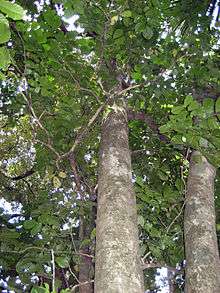Kohekohe
Kohekohe (Dysoxylum spectabile) is a medium-sized tree native to New Zealand. It is found in lowland and coastal forests throughout most of the North Island and also occurs in the Marlborough Sounds in the north of the South Island. Mature trees grow up to 15m in height, with a trunk up to a metre in diameter.
| Kohekohe | |
|---|---|
 | |
| Kohekohe (Dysoxylum spectabile) | |
| Scientific classification | |
| Kingdom: | Plantae |
| Clade: | Tracheophytes |
| Clade: | Angiosperms |
| Clade: | Eudicots |
| Clade: | Rosids |
| Order: | Sapindales |
| Family: | Meliaceae |
| Genus: | Dysoxylum |
| Species: | D. spectabile |
| Binomial name | |
| Dysoxylum spectabile | |
Kohekohe forest used to be common in damp coastal and lowland areas in the North Island, but these forests have mostly disappeared because the land was used for settlement or they were browsed by possums.[1] A fairly close relative of true mahogany (Swietenia), it is also called New Zealand mahogany, because its wood is light, strong and polishes to a fine red colour.[1] Kohekohe is notable for having characteristics normally associated with trees growing in the tropics, for example, its white flowers and red fruit grow directly from the trunk or branches (known as cauliflory), and it has large, glossy, pinnate leaves up to 40mm in length.
Māori boiled the bark in water and drank it as a tonic.[2] The wood was used for building canoes but is soft and not as durable as other woods and tends to rot quickly. It is valued for carving. Kohekohe was probably the dominant vegetation cover on Kapiti Island before it was cleared in the early 19th century for cultivation and farming. The kohekohe forest on Kapiti is recovering after possums were eradicated in 1986.
Gallery
 Fruits
Fruits Flowers
Flowers Foliage
Foliage
References
- "Bushmansfriend - Dysoxylum spectabile Kohekohe - dysoxylum, spectible, kohekohe, bush, forest, ..." Retrieved 22 October 2016.
- "Kohekohe, Dysoxylum - Faculty of Science - The University of Auckland". web.archive.org. 2013-02-08. Retrieved 2020-04-17.
External links
- Maori uses: Medicinal plants, Trees & Shrubs: Kohekohe, Dysoxylum at the Wayback Machine (archived 8 February 2013)